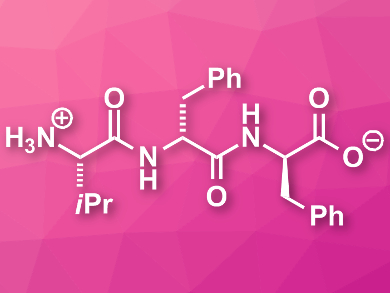Hydrogels formed from short peptides are potentially useful biomaterials. However, their mechanical stability is often insufficient for practical applications. Silvia Marchesan, University of Trieste, Italy, and colleagues have developed an approach that can overcome these problems and introduce beneficial properties such as self-healing and enhanced robustness in the hydrogels.
The team combined self-assembling tripeptide molecules (LLeu-DPhe-DPhe, pictured) with various nanocarbon molecules to create a series of supramolecular hydrogels. They used either 1D, 2D, or 3D oxidized carbon nanostructures (i.e., carbon nanotubes, graphene oxide, or 3D “carbon nanohorns”) to create the different gels. They mixed the peptide and the nanomaterials in an alkaline sodium phosphate buffer and induced gelation by lowering the pH with a mildly acidic buffer solution.
The researchers found that the viscoelastic properties of the hydrogels formed in all cases are strongly affected by the presence of the carbon nanostructures. The nanocarbons cause an increased stiffness and a higher resistance to applied stress. The hydrogel containing 1D nanotubes in addition has self-healing properties. According to the team, this effect could be caused by the nanotubes acting as nucleation templates for reassembly of the structure.
- Oxidized Nanocarbons-Tripeptide Supramolecular Hydrogels: Shape Matters!,
Daniel Iglesias, Manuel Melle-Franco, Marina Kurbasic, Michele Melchionna, Michela Abrami, Mario Grassi, Maurizio Prato, Silvia Marchesan,
ACS Nano 2018.
https://doi.org/10.1021/acsnano.8b01182




